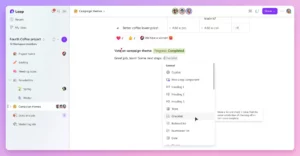Regression in machine learning involves understanding the relationship between independent variables or features and a dependent variable or outcome. Regression’s primary objective is to predict continuous outcomes based on the established relationship between variables.
Machine learning has revolutionized the way we extract insights and make predictions from data. Among the various techniques employed in this field, regression stands as a fundamental approach.
Regression models play a vital role in predictive analytics, enabling us to forecast trends and predict outcomes with remarkable accuracy. By leveraging labeled training data, these models learn the underlying patterns and associations between input features and the desired outcome. This knowledge empowers the models to make informed predictions for new and unseen data, opening up a world of possibilities in diverse domains such as finance, healthcare, retail, and more.
What is regression in machine learning?
Regression, a statistical method, plays a crucial role in comprehending the relationship between independent variables or features and a dependent variable or outcome. Once this relationship is estimated, predictions of outcomes become possible. Within the area of machine learning, regression constitutes a significant field of study and forms an essential component of forecast models.
By utilizing regression as an approach, continuous outcomes can be predicted, providing valuable insights for forecasting and outcome prediction from data.
Regression in machine learning typically involves plotting a line of best fit through the data points, aiming to minimize the distance between each point and the line to achieve the optimal fit. This technique enables the accurate estimation of relationships between variables, facilitating precise predictions and informed decision-making.

In conjunction with classification, regression represents one of the primary applications of supervised machine learning. While classification involves the categorization of objects based on learned features, regression focuses on forecasting continuous outcomes. Both classification and regression are predictive modeling problems that rely on labeled input and output training data. Accurate labeling is crucial as it allows the model to understand the relationship between features and outcomes.
Regression analysis is extensively used to comprehend the relationship between different independent variables and a dependent variable or outcome. Models trained with regression techniques are employed for forecasting and predicting trends and outcomes. These models acquire knowledge of the relationship between input and output data through labeled training data, enabling them to forecast future trends, predict outcomes from unseen data, or bridge gaps in historical data.
Care must be taken in supervised machine learning to ensure that the labeled training data is representative of the overall population. If the training data lacks representativeness, the predictive model may become overfit to data that does not accurately reflect new and unseen data, leading to inaccurate predictions upon deployment. Given the nature of regression analysis, it is crucial to select the appropriate features to ensure accurate modeling.
Types of regression in machine learning
There are various types of regression in machine learning can be utilized. These algorithms differ in terms of the number of independent variables they consider and the types of data they process. Moreover, different types of machine learning regression models assume distinct relationships between independent and dependent variables. Linear regression techniques, for example, assume a linear relationship and may not be suitable for datasets with nonlinear relationships.
Here are some common types of regression in machine learning:
- Simple linear regression: This technique involves plotting a straight line among data points to minimize the error between the line and the data. It is one of the simplest forms of regression in machine learning, assuming a linear relationship between the dependent variable and a single independent variable. Simple linear regression may encounter outliers due to its reliance on a straight line of best fit.
- Multiple linear regression: Multiple linear regression is used when multiple independent variables are involved. Polynomial regression is an example of a multiple linear regression technique. It offers a better fit compared to simple linear regression when multiple independent variables are considered. The resulting line, if plotted on two dimensions, would be curved to accommodate the data points.
- Logistic regression: Logistic regression is utilized when the dependent variable can have one of two values, such as true or false, success or failure. It allows for the prediction of the probability of the dependent variable occurring. Logistic regression models require binary output values and use a sigmoid curve to map the relationship between the dependent variable and independent variables.
These types of regression techniques provide valuable tools for analyzing relationships between variables and making predictions in various machine learning applications.
Interaction of regression in machine learning
Regression in machine learning is primarily used for predictive analytics, allowing for the forecasting of trends and the prediction of outcomes. By training regression models to understand the relationship between independent variables and an outcome, various factors that contribute to a desired outcome can be identified and analyzed. These models find applications in diverse settings and can be leveraged in several ways.
One of the key uses of regression in machine learning models is predicting outcomes based on new and unseen data. By training a model on labeled data that captures the relationship between data features and the dependent variable, the model can make accurate predictions for future scenarios. For example, organizations can use regression machine learning to predict sales for the next month by considering various factors. In the medical field, regression models can forecast health trends in the general population over a specified period.

Regression models are trained using supervised machine learning techniques, which are commonly employed in both classification and regression problems. In classification, models are trained to categorize objects based on their features, such as facial recognition or spam email detection. Regression, on the other hand, focuses on predicting continuous outcomes, such as salary changes, house prices, or retail sales. The strength of relationships between data features and the output variable is captured through labeled training data.
Regression analysis helps identify patterns and relationships within a dataset, enabling the application of these insights to new and unseen data. Consequently, regression plays a vital role in finance-related applications, where models are trained to understand the relationships between various features and desired outcomes. This facilitates the forecasting of portfolio performance, stock costs, and market trends. However, it is important to consider the explainability of machine learning models, as they influence an organization’s decision-making process, and understanding the rationale behind predictions becomes crucial.
Regression in machine learning models find common use in various applications, including:
Forecasting continuous outcomes: Regression models are employed to predict continuous outcomes such as house prices, stock prices, or sales. These models analyze historical data and learn the relationships between input features and the desired outcome, enabling accurate predictions.
Predicting retail sales and marketing success: Regression models help predict the success of future retail sales or marketing campaigns. By analyzing past data and considering factors such as demographics, advertising expenditure, or seasonal trends, these models assist in allocating resources effectively and optimizing marketing strategies.
Predicting customer/user trends: Regression models are utilized to predict customer or user trends on platforms like streaming services or e-commerce websites. By analyzing user behavior, preferences, and various features, these models provide insights for personalized recommendations, targeted advertising, or user retention strategies.
Establishing relationships in datasets: Regression analysis is employed to analyze datasets and establish relationships between variables and an output. By identifying correlations and understanding the impact of different factors, regression in machine learning help uncover insights and inform decision-making processes.
Predicting interest rates or stock prices: Regression models can be applied to predict interest rates or stock prices by considering a variety of factors. These models analyze historical market data, economic indicators, and other relevant variables to estimate future trends and assist in investment decision-making.
Creating time series visualizations: Regression models are utilized to create time series visualizations, where data is plotted over time. By fitting a regression line or curve to the data points, these models provide a visual representation of trends and patterns, aiding in the interpretation and analysis of time-dependent data.
These are just a few examples of the common applications whereregression in machine learning play a crucial role in making predictions, uncovering relationships, and enabling data-driven decision-making.

Regression vs classification in machine learning
Regression and classification are two primary tasks in supervised machine learning, but they serve different purposes:
Regression focuses on predicting continuous numerical values as the output. The goal is to establish a relationship between input variables (also called independent variables or features) and a continuous target variable (also known as the dependent variable or outcome). Regression models learn from labeled training data to estimate this relationship and make predictions for new, unseen data.
Examples of regression tasks include predicting house prices, stock market prices, or temperature forecasting.
Classification, on the other hand, deals with predicting categorical labels or class memberships. The task involves assigning input data points to predefined classes or categories based on their features. The output of a classification model is discrete and represents the class label or class probabilities.
Examples of classification tasks include email spam detection (binary classification) or image recognition (multiclass classification). Classification models learn from labeled training data and use various algorithms to make predictions on unseen data.
Creating an artificial intelligence 101
While both regression and classification are supervised learning tasks and share similarities in terms of using labeled training data, they differ in terms of the nature of the output they produce. Regression in machine learning predicts continuous numerical values, whereas classification assigns data points to discrete classes or categories.
The choice between regression and classification depends on the problem at hand and the nature of the target variable. If the desired outcome is a continuous value, regression is suitable. If the outcome involves discrete categories or class labels, classification is more appropriate.
Fields of work that use regression in machine learning
Regression in machine learning is widely utilized by companies across various industries to gain valuable insights, make accurate predictions, and optimize their operations. In the finance sector, banks and investment firms rely on regression models to forecast stock prices, predict market trends, and assess the risk associated with investment portfolios. These models enable financial institutions to make informed decisions and optimize their investment strategies.
E-commerce giants like Amazon and Alibaba heavily employ regression in machine learning to predict customer behavior, personalize recommendations, optimize pricing strategies, and forecast demand for products. By analyzing vast amounts of customer data, these companies can deliver personalized shopping experiences, improve customer satisfaction, and maximize sales.
In the healthcare industry, regression is used by organizations to analyze patient data, predict disease outcomes, evaluate treatment effectiveness, and optimize resource allocation. By leveraging regression models, healthcare providers and pharmaceutical companies can improve patient care, identify high-risk individuals, and develop targeted interventions.
Retail chains, such as Walmart and Target, utilize regression to forecast sales, optimize inventory management, and understand the factors that influence consumer purchasing behavior. These insights enable retailers to optimize their product offerings, pricing strategies, and marketing campaigns to meet customer demands effectively.
Logistics and transportation companies like UPS and FedEx leverage regression to optimize delivery routes, predict shipping times, and improve supply chain management. By analyzing historical data and considering various factors, these companies can enhance operational efficiency, reduce costs, and improve customer satisfaction.
Marketing and advertising agencies rely on regression models to analyze customer data, predict campaign performance, optimize marketing spend, and target specific customer segments. These insights enable them to tailor marketing strategies, improve campaign effectiveness, and maximize return on investment.

Insurance companies utilize regression to assess risk factors, determine premium pricing, and predict claim outcomes based on historical data and customer characteristics. By leveraging regression models, insurers can accurately assess risk, make data-driven underwriting decisions, and optimize their pricing strategies.
Energy and utility companies employ regression to forecast energy demand, optimize resource allocation, and predict equipment failure. These insights enable them to efficiently manage energy production, distribution, and maintenance processes, resulting in improved operational efficiency and cost savings.
Telecommunication companies use regression to analyze customer data, predict customer churn, optimize network performance, and forecast demand for services. These models help telecom companies enhance customer retention, improve service quality, and optimize network infrastructure planning.
Technology giants like Google, Microsoft, and Facebook heavily rely on regression in machine learning to optimize search algorithms, improve recommendation systems, and enhance user experience across their platforms. These companies continuously analyze user data and behavior to deliver personalized and relevant content to their users.
Wrapping up
Regression in machine learning serves as a powerful technique for understanding and predicting continuous outcomes. With the ability to establish relationships between independent variables and dependent variables, regression models have become indispensable tools in the field of predictive analytics.
By leveraging labeled training data, these models can provide valuable insights and accurate forecasts across various domains, including finance, healthcare, and sales.
The diverse types of regression models available, such as simple linear regression, multiple linear regression, and logistic regression, offer flexibility in capturing different relationships and optimizing predictive accuracy.
As we continue to harness the potential of regression in machine learning, its impact on decision-making and forecasting will undoubtedly shape the future of data-driven practices.
- SEO Powered Content & PR Distribution. Get Amplified Today.
- PlatoAiStream. Web3 Data Intelligence. Knowledge Amplified. Access Here.
- Minting the Future w Adryenn Ashley. Access Here.
- Buy and Sell Shares in PRE-IPO Companies with PREIPO®. Access Here.
- Source: https://dataconomy.com/2023/06/05/what-is-regression-in-machine-learning/
- :has
- :is
- :not
- :where
- $UP
- 1
- a
- ability
- accommodate
- accuracy
- accurate
- accurately
- Achieve
- acquire
- across
- Advertising
- Aiming
- algorithms
- allocation
- Allowing
- allows
- also
- among
- amounts
- an
- analysis
- analytics
- analyze
- analyzing
- and
- Application
- applications
- applied
- approach
- appropriate
- ARE
- AREA
- artificial
- artificial intelligence
- AS
- assist
- associated
- associations
- At
- available
- Banks
- based
- BE
- become
- becomes
- behind
- BEST
- Better
- between
- both
- BRIDGE
- but
- by
- called
- Campaign
- Campaigns
- CAN
- captured
- captures
- Capturing
- care
- categories
- chain
- Changes
- characteristics
- choice
- choosing
- claim
- class
- classes
- classification
- COM
- Common
- commonly
- Companies
- compared
- component
- comprehend
- conjunction
- Consequently
- Consider
- considered
- considering
- consumer
- content
- continue
- continuous
- continuously
- contribute
- Cost
- cost savings
- Costs
- create
- crucial
- curve
- customer
- customer behavior
- customer data
- Customer Retention
- Customer satisfaction
- data
- data points
- data-driven
- datasets
- Deals
- Decision Making
- decisions
- deliver
- delivery
- Demand
- demands
- Demographics
- dependent
- depends
- deployment
- desired
- Detection
- Determine
- develop
- differ
- different
- dimensions
- Disease
- distance
- distinct
- distribution
- diverse
- does
- domains
- due
- e-commerce
- each
- Economic
- economic indicators
- effectively
- effectiveness
- efficiency
- efficiently
- employed
- empowers
- enable
- enables
- enabling
- encounter
- energy
- enhance
- ensure
- equipment
- error
- essential
- establish
- established
- estimate
- estimated
- evaluate
- Every
- example
- examples
- experience
- Experiences
- Explainability
- extensively
- extract
- facial
- facial recognition
- facilitates
- facilitating
- factors
- Failure
- false
- Features
- few
- field
- Fields
- finance
- financial
- Financial institutions
- Find
- firms
- fit
- fitting
- Flexibility
- focuses
- For
- Forecast
- forecasts
- forms
- from
- fundamental
- future
- Gain
- gaps
- General
- given
- goal
- hand
- Have
- Health
- healthcare
- heavily
- help
- helps
- high-risk
- historical
- House
- However
- http
- HTTPS
- identified
- identify
- identifying
- if
- image
- Image Recognition
- Impact
- important
- improve
- improved
- improves
- in
- inaccurate
- include
- Including
- independent
- Indicators
- individuals
- industries
- influence
- inform
- informed
- Infrastructure
- input
- insights
- institutions
- insurers
- Intelligence
- interest
- Interest Rates
- interpretation
- inventory
- Inventory Management
- investment
- investment firms
- involved
- IT
- ITS
- jpg
- just
- Key
- knowledge
- known
- Label
- labeling
- Labels
- leading
- LEARN
- learned
- learning
- Leverage
- leveraging
- like
- Line
- machine
- machine learning
- Machine Learning Techniques
- maintenance
- make
- Making
- manage
- management
- map
- Market
- Market Data
- Market Prices
- Market Trends
- Marketing
- Marketing Campaigns
- Marketing Strategies
- math
- max-width
- Maximize
- May..
- medical
- Meet
- memberships
- method
- ML
- model
- modeling
- models
- Month
- more
- Moreover
- multiple
- must
- Nature
- network
- New
- next
- number
- objective
- objects
- occurring
- of
- offer
- Offerings
- Offers
- on
- once
- ONE
- opening
- operational
- Operations
- optimal
- Optimize
- optimizing
- or
- organizations
- Other
- Outcome
- outcomes
- output
- over
- overall
- past
- patient
- patient care
- patient data
- patterns
- performance
- period
- personalize
- Personalized
- Pharmaceutical
- planning
- Platforms
- plato
- Plato Data Intelligence
- PlatoData
- Play
- plays
- Point
- points
- population
- portfolio
- portfolios
- possibilities
- possible
- potential
- powerful
- practices
- precise
- predict
- predict market
- predicted
- predicting
- prediction
- Predictions
- Predictive Analytics
- Predicts
- preferences
- Premium
- Prices
- pricing
- primarily
- primary
- probability
- Problem
- problems
- process
- processes
- produce
- Product
- Production
- Products
- provide
- providers
- providing
- purchasing
- purposes
- quality
- Rates
- recognition
- Recommendation
- recommendations
- reduce
- reflect
- regression
- relationship
- Relationships
- relevant
- reliance
- rely
- remarkable
- representation
- representative
- represents
- require
- resource
- Resources
- resulting
- retail
- Retail Sales
- retailers
- retention
- return
- revolutionized
- right
- Risk
- risk factors
- Role
- routes
- salary
- sales
- Sales and Marketing
- satisfaction
- Savings
- scenarios
- Search
- seasonal
- sector
- segments
- selection
- Series
- serve
- serves
- service
- Services
- set
- settings
- several
- Shape
- Share
- Shipping
- Shopping
- significant
- similarities
- Simple
- single
- some
- spam
- specific
- specified
- spend
- stands
- statistical
- stock
- stock market
- straight
- strategies
- streaming
- streaming services
- strength
- Study
- success
- such
- suitable
- supervised learning
- supply
- supply chain
- supply chain management
- Systems
- taken
- Target
- targeted
- Task
- tasks
- techniques
- Technologies
- telecom
- terms
- that
- The
- The Area
- The Future
- their
- Them
- These
- they
- this
- Through
- time
- Time Series
- times
- to
- tools
- trained
- Training
- transportation
- treatment
- Trends
- true
- two
- types
- typically
- uncover
- underlying
- understand
- understanding
- underwriting
- undoubtedly
- upon
- us
- use
- used
- User
- User Experience
- users
- uses
- using
- utility
- utilize
- utilized
- Utilizing
- Valuable
- value
- Values
- variety
- various
- Vast
- vital
- vs
- Way..
- ways
- we
- websites
- when
- whereas
- which
- while
- widely
- will
- with
- within
- Work
- world
- would
- zephyrnet












